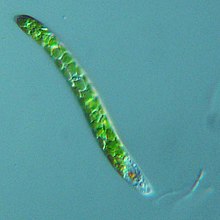Family of flagellate eukaryotes
| Euglenaceae |
 |
| Euglena mutabilis |
Scientific classification  |
| Domain: | Eukaryota |
| Phylum: | Euglenozoa |
| Class: | Euglenida |
| Clade: | Euglenophyceae |
| Order: | Euglenales |
| Family: | Euglenaceae
Dujardin, 1841 |
| Genera |
- Colacium
- Cryptoglena
- Euglena
- Euglenaformis
- Euglenaria
- Monomorphina
- Strombomonas
- Trachelomonas[1]
|
Euglenaceae (also known as Euglenidae) is a family of flagellates in the phylum Euglenozoa. The family includes the most well-known euglenoid genus, Euglena.[1]
Nomenclature
The family Euglenaceae is also known by the name Euglenidae. The origin of this dual naming system is because of the history of protists. Euglenids have been treated as both algae and protozoans, which are governed by separate nomenclature codes.[2] If treated as an alga, it would fall under the International Code of Botanical Nomenclature (ICBN) and its correct name would be Euglenaceae; if treated under the International Code of Zoological Nomenclature (ICZN) it is called Euglenidae.[1] Euglenids such as these are considered to be ambiregnal protists due to their parallel naming systems.[2]
Morphology
Euglenaceae show the most morphological diversity within the class Euglenophyceae.[3] They are mostly single-celled organisms, except for the genus Colacium. They are free-living or sometimes inhabiting the digestive tracts of animals.[1] Two genera, Strombomonas and Trachelomonas produce outer shells called loricae.[4]
As with other euglenids, cells in the Euglenaceae are surrounded by a series of proteinaceous strips called the pellicle; the pellicle can stretch in most genera, allowing the cell to contract, creating a type of movement called metaboly. The genus Monomorphina is rigid or slightly metabolic.[1] Chloroplasts are present in most species, except for a few species that have lost them.[1] Chloroplasts are diverse in this family, with the size, shape, number, and presence of pyrenoids being important identifying characteristics.[1]
Phylogeny
In its current circumscription, Euglenaceae is monophyletic.[4] Its sister family is Phacaceae, which contains several genera (Lepocinclis, Phacus, and Discoplastis) formerly included within Euglenaceae.[4] Two phylogenies are shown below.
Kim et al. (2010)
In this phylogeny, most Euglena species are sister to a clade consisting of Euglenaria and Euglena archaeoplastidiata.[4]
| Euglenales | | Euglenaceae | | | | | | | | | Euglena pro parte | | | | | | | Euglenaria | | | | | Euglena archaeoplastidiata | | | | | | | | | | | | | | | | | | | | | | | | | | | Euglenaformis | | | | | | | | Phacaceae (outgroup) | | | |
| |
Bicudo & Menezes (2016)
This phylogeny places Euglena as sister to all other genera in Euglenaceae except for the genus Euglenaformis.[5]
| Euglenales | | Euglenaceae | | | | | Euglena pro parte | | | | | | | | | | | | | | Euglena archaeoplastidiata | | | | | | | | | | | | | | | | | | | Euglenaformis | | | | | | | | Phacaceae (outgroup) | | | |
| |
References
- ^ a b c d e f g Kostygov, Alexei Y.; Karnkowska, Anna; Votýpka, Jan; Tashyreva, Daria; MacIszewski, Kacper; Yurchenko, Vyacheslav; Lukeš, Julius (2021). "Euglenozoa: Taxonomy, diversity and ecology, symbioses and viruses". Open Biology. 11 (3): 200407. doi:10.1098/rsob.200407. PMC 8061765. PMID 33715388.
- ^ a b Patterson, David J.; Larsen, Jacob (1992). "A Perspective on Protistan Nomenclature". The Journal of Protozoology. 39: 125–131. doi:10.1111/j.1550-7408.1992.tb01292.x.
- ^ Bennett, Matthew S.; Triemer, Richard E. (2015). "Chloroplast Genome Evolution in the Euglenaceae". Journal of Eukaryotic Microbiology. 62 (6): 773–785. doi:10.1111/jeu.12235. PMID 25976746. S2CID 6208110.
- ^ a b c d Kim, Jong Im; Shin, Woongghi; Triemer, Richard E. (2010). "Multigene Analyses of Photosynthetic Euglenoids and New Family, Phacaceae (Euglenales)". Journal of Phycology. 46 (6): 1278–1287. doi:10.1111/j.1529-8817.2010.00910.x. S2CID 86347770.
- ^ Bicudo, Carlos E. de M.; Menezes, Mariângela (2016). "Phylogeny and Classification of Euglenophyceae: A Brief Review". Frontiers in Ecology and Evolution. 4. doi:10.3389/fevo.2016.00017.
- Domain
- Archaea
- Bacteria
- Eukaryota
- (major groups
- Excavata
- Diaphoretickes
- Hacrobia
- Rhizaria
- Alveolata
- Stramenopiles
- Plants
- Amorphea
- Amoebozoa
- Opisthokonta
- Animals
- Fungi)
|
| | | | | Pharyngomonada | |
|---|
| Tetramitia | | Lunosea | |
|---|
| Neovahlkampfiea | |
|---|
| Eutetramitia | |
|---|
|
|---|
|
|---|
| | Postgaardia | |
|---|
| Glycomonada | | Diplonemea | |
|---|
| Kinetoplastea | - Bordnamonadidae
- Trypanophididae
| | Prokinetoplastina | - Prokinetoplastida
- Ichthyobodonidae
- Perkinselidae
|
|---|
| Metakinetoplastina | - Neobodonida
- Allobodonidae
- Neobodonidae
- Rhynchomonadidae
- Parabodonida
- Parabodonidae
- Trypanoplasmatidae
- Bodonida
- Trypanosomatida
|
|---|
|
|---|
|
|---|
| Euglenida | | Petalomonadea | - Petalomonadida
- Petalomonadidae
- Sphenomonadidae
|
|---|
| Alistosa | - Decastavida
- Decastavidae
- Keelungiidae
- Lentomonadidae
- Heterostavida
- Ploeotiida
|
|---|
| Entosiphonea | |
|---|
| Karavia | |
|---|
| Spirocuta | | Anisonemea | |
|---|
| Peranemea | - Acroglissida
- Peranematida
|
|---|
| Euglenophyceae | - Rapazida
- Euglenomonadales
- Eutreptiales
- Euglenales
- Euglenaceae
- Euglenamorphaceae
- Euglenocapsaceae
- Phacaceae
|
|---|
|
|---|
|
|---|
|
|---|
|
|---|
|
|---|
| | | | Anaeromonada | | Anaeromonadea | - Paratrimastigida
- Trimastigida
- Oxymonadida
- Oxymonadidae
- Polymastigidae
- Pyrsonymphidae
- Saccinobaculidae
- Streblomastigidae
|
|---|
|
|---|
| | | Fornicata | |
|---|
| Parabasalia | | Trichonymphea | - Trichonymphida
- †Burmanymphidae
- Hoplonymphidae
- Spirotrichosomidae
- Staurojoeninidae
- Teratonymphidae
- Trichonymphidae
|
|---|
| Trichomonadea | - Hexamastigidae
- Cristamonadida
- Calonymphidae
- Devescovinidae
- Hypotrichomonadida
- Spirotrichonymphida
- Trichomonadida
- Tritrichomonadida
- Dientamoebidae
- Monocercomonadidae
- Simplicimonadidae
- Tritrichomonadidae
|
|---|
|
|---|
|
|---|
|
|
|---|
|
|---|
Taxon identifiers |
|---|
| Euglenaceae | |
|---|
Authority control databases: National  | |
|---|












